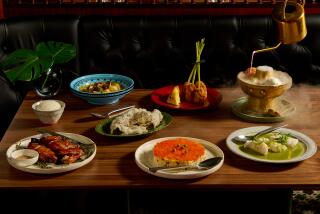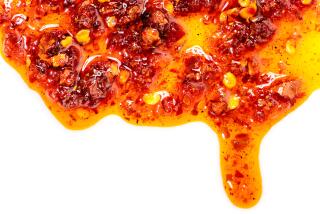If You Prefer Peanuts as a Sauce . . .
- Share via
To anyone raised on peanut butter sandwiches, the taste of Asian peanut sauces can be pleasantly familiar. Recently, the sauces--blended with coconut milk, chiles and pungent curry spices--have become so popular that they’ve started appearing in non-Asian supermarkets either bottled, canned or as dry mixes. Most people first encounter the sauces in Thai restaurants, where satays (grilled meat) with peanut dip are part of the standard repertoire.
This is why most of the sauces you encounter at the grocery store are likely to have Thai labels. Whether they compare to what you would find in a Thai restaurant is another matter.
In a random sampling of eight sauces in the Times Test Kitchen, the two we liked most were a restaurant sauce that served as a standard of comparison and a canned sauce imported from Thailand.
The restaurant sauce, from Sukothai on Beverly Boulevard near downtown Los Angeles, is a smooth blend of red curry paste, peanut butter, coconut milk, sugar and salt that is mildly hot but easy on the palate.
The canned product, labeled sateh sauce, is from Namprik Maesri Ltd. in Nakornpathom, Thailand. It’s thick in texture and hot with chile, and it has good coconut flavor with a slight tang. The price at Bangkok Market is 65 cents for a four-ounce can. This sauce is so thick that it would benefit from thinning down with coconut milk, or even water, which would increase the yield.
Lobo Satay Seasoning Mix from Griffith Laboratories, Thailand, gained few votes. It produced sauce that was thin in taste and texture and intensely hot. The instructions call for adding water to the mix. Milk (presumably coconut) is suggested as an alternative and would undoubtedly improve the flavor. The price at Bangkok Market is 99 cents.
Tommy Tang’s Thai Peanut Sauce is the most expensive of the products sampled--$5.49 for a 12-ounce jar at Bristol Farms. The sauce is fluid and contains chunky bits of peanuts, but to the tasters its flavor, though markedly tangy, seemed less rich and went off on its own tangent.
A Taste of Thai Peanut Sauce Mix, carried at Pavilions, emphasizes creaminess. A cross between it and the Tommy Tang sauce would probably be quite nice. The price for a package that contains two envelopes, each of which makes one cup sauce, is $2.15. To make the sauce, you add three tablespoons oil and three-quarters cup coconut milk to the contents of one envelope, bring to a boil and simmer four minutes.
Peanut sauce is also part of the cuisines of Malaysia, Singapore and Indonesia. Ayam Brand Satay Sauce, a Malaysian product purchased at L.A. Super Market in Chinatown, compares fairly successfully to what you might get at a food stall in a Malaysian town. One of the hotter sauces, it is full-flavored, thick and rather oily--too oily, probably, for fat-conscious Americans.
Two other sauces are liquid, rather than thick or chunky. Lagura Thick Satay Sauce, from Lagura Foods in Orange, does not claim to be Thai. Although the ingredients include roasted peanuts, this sauce tastes primarily like dark sweet soy sauce. The price at Ralphs is $2.19 for a 9.4-ounce bottle.
San-J Thai Peanut Sauce, made in Japan, tastes very little like what Americans think of as Thai peanut sauce. The label explains that it is an all-purpose stir-fry and dipping sauce. Taken straight as a dip, it is strong and salty. But as a component of a sauce mixture or a stir-fry dish, it has potential.
The sauce is new and is stocked at major natural foods stores; it should be in chain supermarkets within a month or two. The price is $3.19 for a 10-ounce bottle, $2.79 for a five-ounce bottle.
More to Read
Eat your way across L.A.
Get our weekly Tasting Notes newsletter for reviews, news and more.
You may occasionally receive promotional content from the Los Angeles Times.










